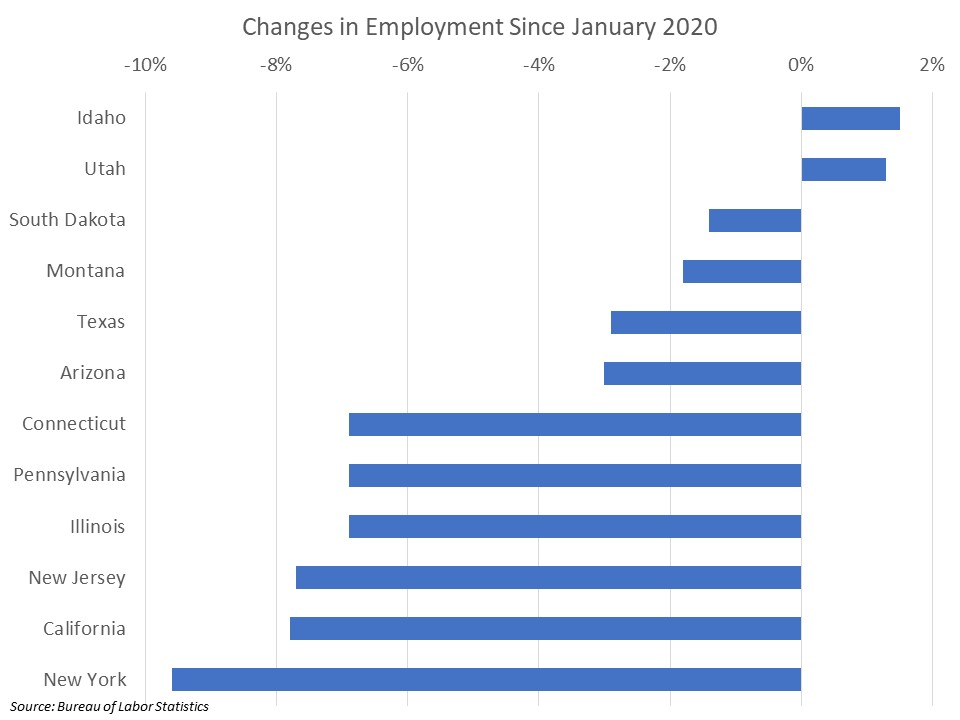
The governors of America’s “growth corridor” states have made economic recovery from the COVID-19 shutdowns a priority.
While blue state governors went wild with draconian lockdowns, governors like Ron DeStantis of Florida and Greg Abbott of Texas were busy finding ways to reopen their states’ massive economies safely, and to put real money back in their residents’ pockets.
South Dakota barely shut down, with governor Kristi Noem prioritizing the whole health of her constituents, rather than just focusing on the narrow risk posed by COVID-19.
Now, the common sense measures taken by governors of red states are paying back dividends. The Wall Street Journal reports on the differences in recovery between lockdown states and growth corridor states. Allysia Finley and Esther Plecy write:
The unemployment rate in April nationwide was 6.1%, but this obscures giant variations in the states. With some exceptions, those run by Democrats such as California (8.3%) and New York (8.2%) continued to suffer significantly higher unemployment than those led by Republicans such as South Dakota (2.8%) and Montana (3.7%).
It’s rare to see differences that are so stark based on party control in states. But the current partisan differences reflect different policy choices over the length and severity of pandemic lockdowns and now government benefits such as jobless insurance.
Nine of the 10 states with the lowest unemployment rates are led by Republicans. The exception is Wisconsin whose Supreme Court last May invalidated Democratic Gov. Tony Evers’s lockdown. The unemployment rate in Wisconsin is 3.9%—the same as Indiana—compared to 7.1% in Illinois whose Gov. J.B. Pritzker has been slow to reopen.
Jobs may be slow to recover in severe lockdown states if businesses shut down permanently. There may also be a delayed wave of small business closures once owners use up Paycheck Protection Program loans. While Congress made the loans forgivable, businesses that didn’t spend 60% of the proceeds on payroll will have to pay them back.
That includes a lot of restaurants and personal care services that were forced to close their doors and lay off workers during lockdowns but still had to pay rent and other overhead costs. In short, the labor market recovery in many states may be slower than it should be.
Restaurant booking website OpenTable shows reservations in Florida have been running about 20% higher in May than on the same dates in 2019 but are still down 40% to 60% in New York. Restaurants in Miami have reported booming business while those in New York City have lost many of their upper-crust patrons.
Speaking of moving, Idaho and Utah have both experienced a recent surge of migrants from other states, according to Census data, and have gained jobs since January 2020. Most states in the Midwest, South and Mountain West aren’t far off their pre-pandemic employment peaks. One obstacle to a faster recovery may be the $300 federal unemployment bonus, which many GOP governors are rejecting.
Meantime, states with Democratic governments continue to reward workers for sitting on the couch. The longer that workers stay unemployed, the harder it will be to get them to return to work. Don’t be surprised if the economic recovery’s geographic bifurcation grows in the coming months.
Twenty-three GOP-run states have plans to end the added unemployment benefits early to help feed their roaring economies. As of May 25, that list included:
- Alabama
- Alaska
- Arizona
- Arkansas
- Florida
- Georgia
- Idaho
- Indiana
- Iowa
- Mississippi
- Missouri
- Montana
- New Hampshire
- North Dakota
- Ohio
- Oklahoma
- South Carolina
- South Dakota
- Tennessee
- Texas
- Utah
- West Virginia
- Wyoming
Action Line: If you want to run your business, or retire, like to where your money and time are respected, head for America’s growth corridors. You can learn to Survive and Thrive, even in Joe Biden’s America, by clicking here to sign up for my free monthly newsletter. You’ll be glad you did.
Originally posted on Your Survival Guy.





